Suspension tuning allows you to make a vehicle drive the way you want.
People often think they’re stuck with what they get when they purchase a vehicle. All cars drive differently and have unique feels, but tuning your suspension is a way to make a vehicle feel like the ones you’ve always enjoyed driving.
If you’re someone that’s looking to get the most performance out of their vehicle, you’ll need to start altering the settings of your suspension.
Tuning a vehicle’s suspension is more than changing how high it is off the ground. You’ll need to play with several settings as they’re all equally important.
Keep on reading to learn how to tune your vehicle’s suspension.
Damper
One of the first things you’ll need to look at on your vehicle is the bound and rebound settings. The damper is the shock absorber of your vehicle’s shocks. The bound of the damper is how much the shock allows compression and the rebound is how much the shock releases compression.
Some vehicle suspensions will have dampening controls, and you should tinker with the settings if they do. It’s also possible to do these adjustments electronically depending on what kind of setup you have.
Camber
The camber is the angle of your wheel when on the road. If the wheel is rolling outwards, it has a positive camber. If the wheel is rolling inwards, it has a negative camber.
Whenever the car rolls into a corner, your camber will be responsible for most of the handling and how the impact affects your tires. The problem with racing suspensions is that the best camber setting will cause your tires to wear down quickly.
The front wheels of a vehicle are often set to have a negative camber to allow it to turn better. Over time, the increased pressure from being rolled inwards will start breaking down the tread on the tires.
If you’re someone that only cares about race performance, you’ll want to tune your camber to match this setup. However, anyone looking to get the most longevity out of their vehicle should aim to keep their camber setting as close to the manufacturer’s as possible.
Anyone looking to see the default settings of their vehicle’s suspension can look at this website, which provides a plethora of vehicle manuals.
Keep in mind that when you’re driving with a negative camber setting, hitting a bump can mess with the setting because your tires will be more likely to shift out of position.
Caster
Casters are similar to cambers in that they relate to the position of the wheels. Instead of going from side to side, caster settings involve the wheel hub’s angle.
A positive caster is what people aim for because it will keep the wheel straight and stable. When you have a neutral camber, your wheels will be more susceptible to wobbling around.
Toe
Toe-in and toe-out pertain to a vehicle’s stability as they refer to a wheel’s alignment. Imagine a straight line cutting through your vehicle from the back to the front.
When the front wheels are pointing inwards from the front, that’s considered a toe-in configuration. When they’re pointing outwards, it’s a toe-out configuration.
Both of these settings are practical depending on when you’re using them. While choosing either setting is preferential, toe-in settings are often used when driving on the road whereas toe-out settings are used on race tracks.
Anyone that’s looking to drive their car casually will use toe-in and racers will use toe-out. Keep in mind that your vehicle’s suspension will determine how much you’ll be able to mess with these settings because the wheels could end up rubbing against the body of the vehicle.
When you start changing the toe settings, ensure that you don’t alter the rear tires as much as the front ones. The rear tires should have a lower angle.
Roll
Roll is important when tuning the suspension of a vehicle, especially when it comes to fast fast AWD cars. Eliminating roll helps a vehicle remain stable when turning corners.
When cars are quickly turning corners, it’s common to see one of the rear wheels lift off the ground. However, turning corners effectively and safely requires all of the wheels to be on the ground for as long as possible.
To do this, you can install a roll bar in your vehicle. This will keep the car stable when turning because it will take the lift and move it to the other side of the car.
Spring Stiffness
You must ensure that your springs aren’t stiff or else your vehicle will bounce a lot as it hits bumps. Having balanced suspension traction is all about having soft shocks that can absorb all of the lumps in a road.
Most modern shocks will be adjustable, so you should tune your shocks to match your driving style.
Start the Suspension Tuning Process Today
If you’re someone that would like to get the most of your vehicle, you’ll need to start turning your suspension to maximize its performance. Suspension tuning is all about choosing the right settings to ensure your vehicle has the most control.
Whether you’re driving the fastest FWD car or driving with bad front differential, tuning your suspension will make your vehicle efficient and safe. Start by altering the damper and camber settings, then continue to go down the list.
Take a look at our articles to learn more about automotive-related topics.

